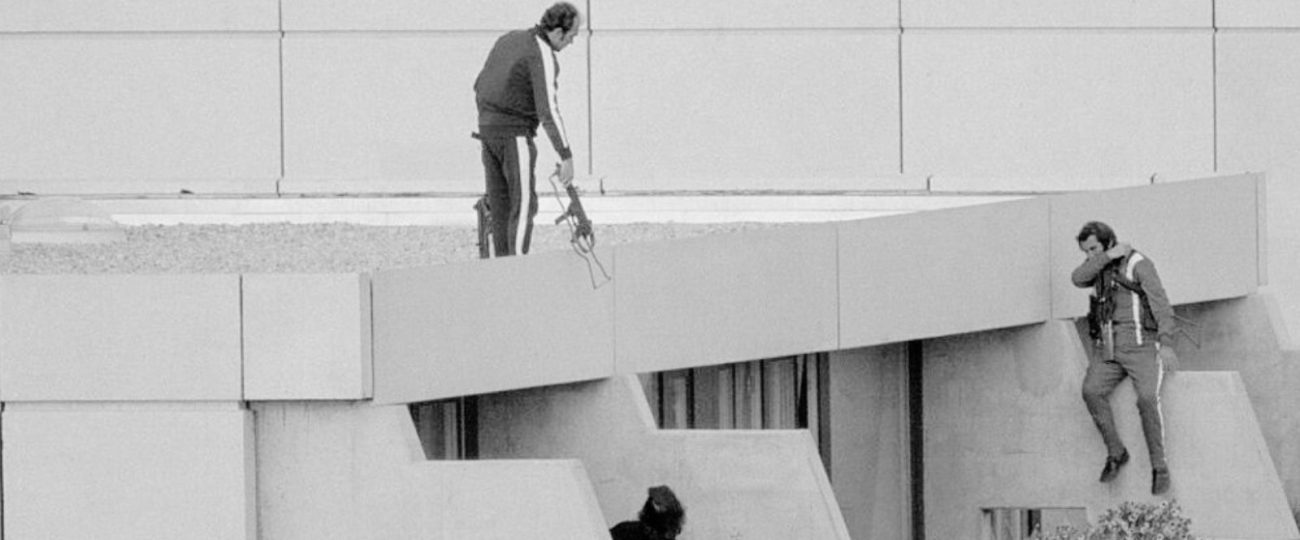What Happened On September 5th?
In the early hours of September 5, 1972, eight members of the Palestinian militant group Black September infiltrated the Olympic Village in Munich, Germany. The XX Olympic Summer Games were supposed to represent global unity, but lax security left the athletes exposed. Dressed as athletes themselves, the attackers climbed over the perimeter fence without being stopped. Security guards mistook them for competitors returning late, allowing the militants to make their way to 31 Connollystrasse, where the Israeli Olympic team stayed.
At 4:30 a.m., the militants broke into the apartment of the Israeli athletes. Wrestling coach Moshe Weinberg tried to fend off the attackers, buying enough time for some of his teammates to escape through a window. Despite his resistance, Weinberg was shot and killed. Weightlifter Yossef Romano, who had been recovering from a knee injury, also fought back but was shot and left to die in the apartment. His body remained in the room with the hostages for the duration of the standoff, a grim psychological tactic used by the attackers to terrify the others. The militants then took nine remaining Israeli athletes and coaches hostage.
Issa, the leader of the attackers, delivered his demands: the release of 234 Palestinian and Arab prisoners from Israeli jails, along with the release of two members of the German Red Army Faction. The hostage crisis escalated into a global emergency, with the world glued to television sets as events unfolded live.
Issa understood the power of the media. He controlled the flow of information by periodically allowing journalists to speak with the authorities. The hostages were shown at windows to demonstrate they were still alive, keeping the world on edge. The militants used the media to their advantage, ensuring that their political message was broadcast worldwide.
German negotiators scrambled to resolve the crisis. They offered a large sum of money to the militants, hoping it would bring an end to the situation, but Issa rejected the offer without hesitation. Desperate, the Germans proposed swapping high-ranking officials for the Israeli athletes, hoping that the attackers would accept. Issa refused again, signaling that the hostages were a crucial part of their plan and not bargaining chips for personal gain.
German authorities, who lacked a dedicated counter-terrorism unit, improvised a rescue plan. A group of police officers disguised as flight attendants prepared to ambush the militants on a jet that was supposedly going to transport them to Cairo. However, the officers withdrew at the last moment, realizing they were ill-equipped and under-trained for such a high-stakes mission. What many did not know at the time was that Germany had no specialized anti-terror units, a gap in national security that contributed to the disastrous handling of the crisis.
As the hours ticked by, the militants grew increasingly agitated. The negotiators finally agreed to transport them, along with the hostages, to Cairo. Helicopters took the group to Furstenfeldbruck Air Base, where German snipers had set up an ambush. The plan, however, was poorly conceived from the start. The snipers, hastily assembled, lacked night-vision equipment and radios, making it impossible to communicate effectively during the operation. Additionally, German officials had incorrectly estimated the number of attackers, believing there were five instead of eight.
When the helicopters touched down at the airfield, the militants inspected the plane meant to take them to Cairo and quickly realized it was a decoy with no flight crew. A gunfight erupted between the militants and the German snipers. Amid the chaos, one of the militants threw a grenade into a helicopter, killing the hostages inside. The remaining hostages were shot at close range as the situation spiraled out of control. By the time the gunfire ceased, all nine hostages had been killed, along with five of the militants.
In the weeks following the massacre, tensions escalated again when West Germany agreed to release the three surviving militants. A Palestinian faction hijacked Lufthansa Flight 615, demanding the militants’ freedom. West Germany complied, releasing the attackers, much to the fury of the Israeli government. Interestingly, the Israelis had already planned a covert operation to capture or kill the surviving militants, but this plan was abandoned when the Germans assured Israel that they would hold the attackers accountable. The release of the militants not only outraged Israel but also undermined Germany’s credibility on the world stage.
Israeli officials had warned German authorities about potential threats to their athletes well before the Games began. They had requested increased security measures, recognizing that their athletes could be targeted due to political tensions in the Middle East. However, West German officials, intent on creating an image of peace and openness, assured the Israelis that the Olympic Village was secure. The focus on a relaxed, peaceful atmosphere led to inadequate security, which allowed the attackers to enter the Village without resistance.
In the days leading up to the attack, the militants scouted the Village and observed the daily movements of the Israeli athletes. They took note of the weak security around the Israeli apartments and planned their assault accordingly. What few people knew at the time was that the attackers had been tipped off by an informant within the Olympic Village.
The massacre at Munich exposed serious gaps in international security measures, particularly at high-profile events like the Olympics. Despite the clear threats posed, the lack of preparation and failure to heed warnings paved the way for one of the most devastating terrorist attacks in modern history.





